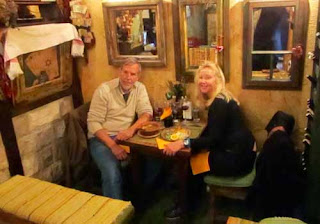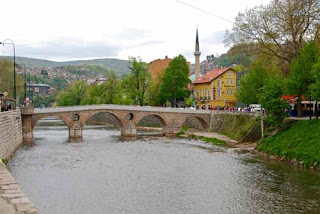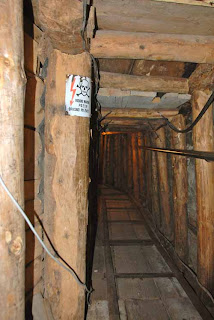 |
| Wayne & Pat at Restaurant - Sarajevo, Bosnia |
 |
| Sebilj Fountain in Pigeon Square - Sarajevo, Bosnia |
 |
| Latinsak Cuprija (Latin Bridge) - Sarajevo, Bosnia |
 |
| Wayne Feeding Pigeons at Pigeon Square - Sarajevo, Bosnia |
SarajevoBosnia.JPG) |
| Glavna Posta (Main Post Office) - Sarajevo, Bosnia |
 |
| Goat Bridge - Sarajevo, Bosnia |
 |
| View of Sarajevo, Bosnia |
 |
| Girl with Pigeons - Sarajevo, Bosnia |
 |
| War Tunnel - Sarajevo, Bosnia |
 |
| Burek with Coffee for Breakfast - Sarajevo, Bosnia |
Sarajevo is an interesting place - East meets West!
Within minutes in Sarajevo, you can walk from eastern Ottoman cobbled streets with mosques and open oriental-style markets (Bascarsija) to western 19th century Austrian/Hungarian building and smooth stone paved streets.
We stayed in the middle of Sarajevo's old town having dinners in quaint restaurants and lunch at the famous Pivnica HS brewery that makes the popular Sarajevsko beer (pivo).
We had breakfast of coffee and burek (a meat and cheese pastry) and had fun feeding the pigeons at Pigeon Square around the Sebilj Fountain with the Čaršijska mosque in the background. Sarajevo’s main post office is one the most beautiful we have ever been in (see photo).
We had breakfast of coffee and burek (a meat and cheese pastry) and had fun feeding the pigeons at Pigeon Square around the Sebilj Fountain with the Čaršijska mosque in the background. Sarajevo’s main post office is one the most beautiful we have ever been in (see photo).
A lot of history... History abounds in Sarajevo, a city of 400,000 people of Bosnia’s 4-million population! Sarajevo is the place where the Western and Eastern Roman Empire split and where the people of the Roman Catholic west, Eastern Orthodox east, and the Ottoman south met, lived and warred.
In Sarajevo’s old town at the Latin Bridge is where the assassination of the Archduke of the Austro-Hungarian Empire, Franz Ferdinand, happened in 1914 plunging the world into WWI. See the photo of the Latin Bridge.
In Sarajevo’s old town at the Latin Bridge is where the assassination of the Archduke of the Austro-Hungarian Empire, Franz Ferdinand, happened in 1914 plunging the world into WWI. See the photo of the Latin Bridge.
More recently (1992-95), it is a shame that the pretty city of Sarajevo, that hosted the 1984 Winter Olympics and served as a model where Muslims, Orthodox and Roman Catholic Christians, and Jews lived and worked within blocks of each other, burst into one of the worst modern day war sieges and three bloody years of ethno-religious civil strife.
Even more history... After independence was declared in 1992, the Bosnian Serbs supported by neighboring Serbia and Montenegro responded with armed resistance aimed at partitioning the republic along ethnic lines and joining Serb-held areas together to form a "greater Serbia." Muslim Bosniaks and Croats resisted resulting in Sarajevo being surrounded and shelled daily for years. This caused production to plummet by 80% and unemployment to soar.
Even more history... After independence was declared in 1992, the Bosnian Serbs supported by neighboring Serbia and Montenegro responded with armed resistance aimed at partitioning the republic along ethnic lines and joining Serb-held areas together to form a "greater Serbia." Muslim Bosniaks and Croats resisted resulting in Sarajevo being surrounded and shelled daily for years. This caused production to plummet by 80% and unemployment to soar.
 |
| Map of Bosnia and Herzegovina |
They dug a 2,400-foot tunnel under the UN-declared safe zone of the airport where they brought in food and weapons. You have to bend over to walk along the tunnel. The war ended in a negotiated truce and today there are two governments that govern Bosnia and many issues remain unresolved.
Please see our other interesting post on Bosnia:
Mostar, Bosnia
Please enjoy 250+ wonderful places around the world, with award-winning photos, from our BLOG ARCHIVE on the right ---->
Travel of half the cost for all levels of travel from budget to luxury and 100's of other unique travel tips! From a
former Economic professor, experienced traveler
(106 countries), award-winning travel photojournalist/blogger, featured speaker at large travel shows,
host of the travel TV show Plan Your Escape® TV aired on the CW network,
and travel columnist for the Huffington Post, our popular 5-star customer rated groundbreaking and comprehensive how-to world travel book Plan Your Escape, Secrets of Traveling the World for Less Than the Cost of Living at Home reveals secrets how you can travel & see more for half
the cost for all trips from weekend getaways to longer vacations and trips, experience
more adventure and romance, safely realize your travel dreams with comprehensive planning tools and checklists, travel
the world for less than $100/day for a couple, and much more!












